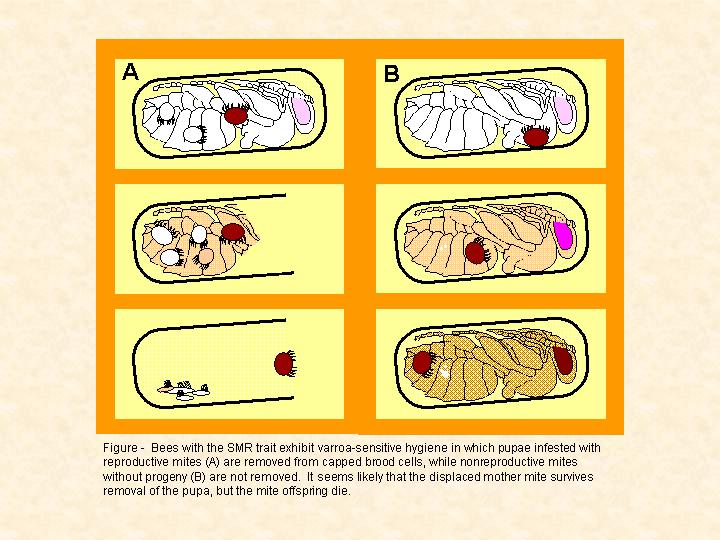| Varroa Sensitive Hygiene (VSH) |

|
The SMR/VSH trait explained by hygienic behavior of adult bees
We produced varroa resistant honey bees by selectively breeding from colonies with high percentages of infertile mites (Breeding Honey Bees that Suppress Mite Reproduction). The heritable trait in bees which causes high percentages of infertile mites was termed "suppression of mite reproduction" (or SMR trait) because we thought that the bees were directly interfering with mite reproduction (Harris & Harbo, 2000, Apidologie 31: 689-699). A mechanism explaining the SMR trait has not been described, but Ibrahim and Spivak (2003, ABJ 144: 406) found that bees with the SMR trait were very hygienic and were able to remove varroa-infested pupae from capped brood cells. They also suggested that SMR bees may selectively remove pupae having reproductive mites.
We tested this hypothesis by transferring naturally infested and recently capped brood combs into control and SMR colonies. The two types of recipients had different levels of mite fertility (as defined in Harris & Harbo, 1999, J. Econ. Entomol. 92: 83-90) before this experiment: control colonies averaged 20 ± 10 % infertile mites, while SMR colonies averaged 97 ± 6 % infertile mites (mean ± SD).
Seventeen combs were obtained from 7 source colonies. Sources had an average infestation of 12 mites per 100 capped worker cells, and 71 % of the mites were reproductive. Each source provided at least 2 combs, one into each type of recipient colony. The infestation rate and percentage of infertile mites were measured for all transferred combs after 7-9 days in recipient colonies.
Analyses were restricted to cells infested by a single varroa foundress because few multiply infested cells were found (17 in a total of 329 infested cells). Fewer mites were found in combs that had been transferred to SMR colonies (Table). This suggests the hygienic removal of infested pupae by the adult bees with the SMR trait. SMR bees removed 91 % of pupae having reproductive mites and 58 % of pupae having infertile mites that had produced progeny. Pupae having infertile mites that had no offspring were apparently not removed (Table). Thus, the cue for varroa-sensitive hygiene by bees with the SMR trait is probably related to the presence of mite offspring (Figure).
Table - Comparison of mite populations between combs that were transferred into control and SMR colonies. Newly capped cells of naturally infested brood were transferred, and mite populations were evaluated 7-9 days later by examining cells containing pupae that were 3 days from emergence.
| Variablea
|
Combs into control colonies |
Combs into SMR colonies (n=9) |
Comparison of Least Squares Means | ||
| t | dfb | Pr > |t| | |||
|
Percentage of infertile mites |
31 ± 3% | 78 ± 4% | 8.44 | 15 | <0.0001 |
| No. reproductive mitesc | 5.6 ± 0.6 | 0.5 ± 0.4 | 7.39 | 8.28 | <0.0001 |
| No. infertile mites with progenyc, d | 1.2 ± 0.2 | 0.5 ± 0.1 | 3.63 | 15 | <0.003 |
| No. infertile mites without progenyc | 1.0 ± 0.2 | 1.0 ± 0.2 | 0.20 | 12.4 | >0.8 |
| No. dead mitesc, e | 0.4 ± 0.1 | 0.2 ± 0.1 | 1.47 | 15 | >0.15 |
| Total infested cellsc | 8.1 ± 0.8 | 2.1 ± 0.6 | 5.94 | 15 | <0.0001 |
Footnotes for Table
a) Least squares mean ± SE for each group of combs were determined post ANOVA. The model included (1) type of recipient colony (fixed effect), (2) source of infested comb (random effect), and (3) type of recipient ± source of infested comb (random effect). The model for the percentage of infertile mites was weighted by the total number of singly infested cells from each comb, and the models for all other variables were weighted by the total number of brood cells that were examined from a comb.
b) Degrees of freedom were estimated using the Kenward-Roger method (Proc Mixed, SAS Institute).
c) Values reported as number of mites per 100 capped worker brood cells.We examined 315 ± 35 and 563 ± 180 (mean ± SD) capped worker cells in each comb that had been transferred into control and SMR colonies, respectively.
d) Infertile mites with progeny included (1) foundress mites that had only a son, and (2) those whose oldest daughter could not mature before the host bee emerged from the brood cell (see Martin, 1994, Exp. Appl Acarol 18: 87-100).
e) All dead foundress mites had no progeny.

